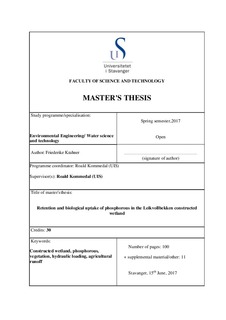| dc.contributor.advisor | Kommedal, Roald | |
| dc.contributor.author | Krahner, Friederike | |
| dc.date.accessioned | 2017-10-04T11:13:14Z | |
| dc.date.available | 2017-10-04T11:13:14Z | |
| dc.date.issued | 2017-06-15 | |
| dc.identifier.uri | http://hdl.handle.net/11250/2458341 | |
| dc.description | Master's thesis in Environmental engineering | nb_NO |
| dc.description.abstract | Phosphorous is the limiting nutrient for primary production in freshwater systems and excessively applied as inorganic fertilizer in agriculture. Elevated phosphorous concentrations in recipients can cause eutrophication which reduces the recipient water quality. The main focus of this study is to investigate the retention of phosphorous in a mature constructed wetland and the phosphorous uptake and removal in/with plant biomass. The constructed wetland studied is a two pond free water surface system treating agricultural runoff to improve the water quality of the adjacent recipient. The investigation of the phosphorous retention includes determination of retention of different phosphorous fractions, and how their retention is influenced by other parameters. Furthermore, the uptake of phosphorous by plants is studied and the amount of phosphorous that can be removed by harvesting vegetation is determined. The determination of phosphorous retention/removal by physiogeochemical and biological processes was achieved by performing weekly analyses of water and plant samples. Water samples were analyzed for total phosphorous, total dissolved phosphorous and phosphate. Additional analysis of total and dissolved iron, turbidity, total suspended solids, and color were performed to identify a possible impact on phosphorous retention. Plant samples were analyzed for total phosphorous content in root, stem and leave. The total phosphorous retention efficiency in the constructed wetland was 31 %, which accounts for 19.9 kg P/year. The phosphate retention was only 3 %, which accounts for 0.3 kg P/year. The total amount of phosphorous that could be removed by harvesting vegetation of one pond once a year was 2.42 kg P/year, which accounts for 4 % of the total phosphorous mass entering the wetland per year. The sedimentation zones in the constructed wetland are filled up with sediment, which causes particle wash-out at high hydraulic loadings and a low retention of phosphorus. Sediment conditions are not favorable for phosphate retention, as adsorption sites are saturated and precipitation with iron cannot occur. The latter may be due to anaerobic conditions during winter and a too high pH-value. The efficient phosphorous retention depends on the regular sediment and/or biomass withdrawal and the avoidance of peak flow sediment wash out by implementing a storm water by-passing. | nb_NO |
| dc.language.iso | eng | nb_NO |
| dc.publisher | University of Stavanger, Norway | nb_NO |
| dc.relation.ispartofseries | Masteroppgave/UIS-TN-IMN/2017; | |
| dc.rights | Navngivelse 4.0 Internasjonal | * |
| dc.rights.uri | http://creativecommons.org/licenses/by/4.0/deed.no | * |
| dc.subject | environmental technology | nb_NO |
| dc.subject | teknisk miljøvern | nb_NO |
| dc.subject | vann | nb_NO |
| dc.subject | våtland | nb_NO |
| dc.subject | agricultural runoff | nb_NO |
| dc.subject | fosfor | nb_NO |
| dc.title | Retention and biological uptake of phosphorous in the Leikvollbekken constructed wetland | nb_NO |
| dc.type | Master thesis | nb_NO |
| dc.subject.nsi | VDP::Technology: 500::Environmental engineering: 610 | nb_NO |

